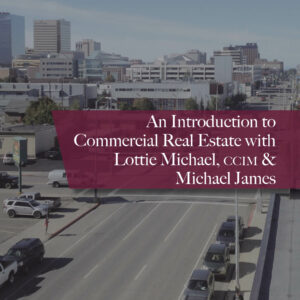
Published in Anchorage Daily News on 2.29.24
By Connie Yoshimura
Every day we drive past restaurants, office buildings, big box stores and then one day the sign changes and we wonder what happened. Most likely that’s the work of a commercial real estate licensee that may have taken months if not a couple of years to change. Aside from the commercial for sale or lease signs with their name, you’re not likely to find commercial licensees on You Tube videos or offering their properties on Facebook. They’re not an underground group of warriors but a select group of real estate licensees who have dedicated their professional life to work in the commercial world of real estate. I am not one of those individuals. My career has been and will always be assisting buyers and sellers with their residential real estate needs and the development of residential neighborhoods. So when it comes to commercial, I know just enough to be dangerous and have learned the hard way that even as a business owner negotiating their own office lease space can be caught with hidden costs without market knowledge and how CAM costs are split.
Lottie Michael, CCIM, and Michael James lead Berkshire Hathaway’s commercial division and have been in that commercial world and together represent almost 70 years of commercial real estate in Alaska from Ketchikan to Barrow to downtown Anchorage. They exclusively represent for the entire state of Alaska. Together, they provide data and information on Alaska ‘s commercial real estate market. Their work includes Acquisition and Disposition to enhance systems necessary to maximize return on invested capital, cash-on cash, internal rate of return, reversion analysis and 1031 exchanges. They provide to their local and national clients Asset Management to ensure a professional understanding of enhancement criteria required to maximize value of retail, office, multi-family, industrial and land assets. Capitalization rates, real estate analytics and various valuation methodologies are also what they provide. That sign change you just drove by requires an encyclopedia of knowledge that YouTube, AI and Facebook can never provide but is the breeding ground for residential.
Office leasing includes medical, professional and ‘other’ such as nail salons, mini spas and walk-in massage. Retail includes national, regional and local stores such as REI, Michael’s, Sadlers and Tiny Gallery and similar boutiques. Hospitality includes hotel and restaurants, all of which requires knowledge of state and local laws. Industrial includes an understanding of rental income vs. Developments. Owner-occupied or as leased investments. All of those types of businesses are located in commercial zoning districts and each district from B3 to I1 have their own regulations. Land sales and multi-family are also part of commercial real estate. Commercial real estate sales, disposition and valuation is different than commercial property management. Commercial property managers handle accounting, rent collection, tenant relations, lease administration, marketing, insurance and legal issues. Although it seems like property managers are also capable of commercial for sale and lease analysis, the skill set is definitely different.
Here is a Commercial market update from Lottie & Michael
“In our opinions the commercial real estate market is alive and well. A quick snapshot reveals the industrial market is short on inventory whether the interest is in buying or leasing. We are unaware of any speculative warehouses being developed. As a real estate investment, cost of new construction far surpass market lease rates and purchase prices. Owner-users may develop a warehouse for their business, however that is a function of business needs rather than a real estate investment.
The retail market is interesting. Vacancies of 1,000 – 4,000 SF are being leased. 10,000 – 20,000 square foot spaces are difficult to identify in good locations. Cannabis industry, good or bad, has given parts of Anchorage a new look. Because of banking and geographic restrictions placed on Cannabis businesses, many have located in older properties. Those buildings have often received exterior as well as interior renovations. Rental rates for cannabis businesses command a 25-50% premium.
The vacancy rate for Class A is greater than it may appear. Subleases and short term leases skewer rates. For the most part, keeping a tenant, even with concessions may be preferable to a vacancy.
Multifamily properties continue to demand sale prices with CAP rates as low as 7%.
Medical office space and medical office buildings can cost $300. – $700/SF. to build out from a vanilla shell. Higher costs of build out are attributed to higher quality finishes, design cost, more intensive needs relating to mechanics, plumbing, electrical, with consideration must be given for on-site generators, gases, more parking designated for handicap. Insurance providers have been know to demand awnings or covered entry doors for ease of EMT vehicles or visitors requiring an ice free entrance.
A good bellwether of the economy is hospitality. It may not easily identifiable however, the restaurant industry has been busy with turnovers to new operators. There are new players in our town’s restaurant business. For various reasons, where one operator fades away, another sees an opportunity. With that opportunity we see renovations, new energy and reinvestment in our community.”

 Connie Yoshimura is the Owner and Broker of Berkshire Hathaway HomeServices Alaska Realty. With over 40 years of residential real estate experience, she continues to be a leader in Alaska’s housing market. Most recently, she sold the highest-priced home ever recorded in the Alaska MLS.
Connie Yoshimura is the Owner and Broker of Berkshire Hathaway HomeServices Alaska Realty. With over 40 years of residential real estate experience, she continues to be a leader in Alaska’s housing market. Most recently, she sold the highest-priced home ever recorded in the Alaska MLS.
Leave a Reply